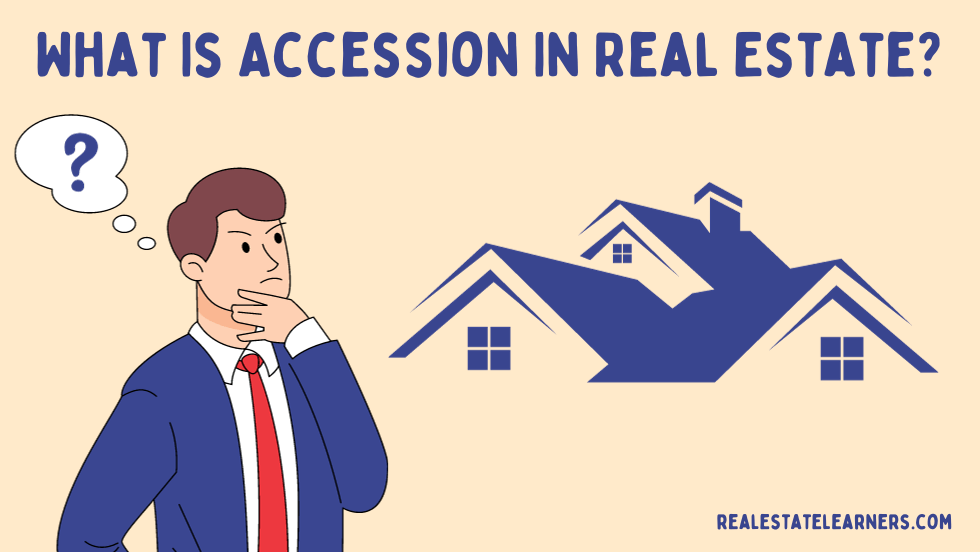If you’ve ever wondered what accession real estate means, it’s time to get some answers. From understanding the legal terminology and how it applies to owning property to knowing how legislation impacts your purchase decisions and long-term ownership expectations – accession real estate is an important concept.
Depending on your particular goals in purchasing or selling such a property, accession can significantly impact the result of any transaction. In this post, we’ll look at the accession definition of real estate and how it can affect your investment choices.
What is accession in real estate?
Accession real estate definition differs in property, common, and commercial law. In real estate, accession refers to an owner’s right to any improvements or additions made to their property. These improvements can include new buildings, structures, or items permanently attached to the land.
Accession is essential in real estate as it gives owners the legal right to claim ownership over these added improvements and prevents others from taking or using them without permission. It also allows the owner to be compensated if a third party made these improvements without their consent. Overall, accession protects an owner’s property rights and ensures they control any changes or additions to their land.
What is Stealing in Accession by Real Estate?
Stealing in accession by real estate refers to the unauthorized taking or use of added improvements or additions made to a property without the owner’s consent. This can occur when someone intentionally takes or uses these improvements, knowing they were not the original owner and did not have permission to do so. This type of stealing violates an owner’s property rights and can result in legal consequences.
This can include clearly marking ownership of added improvements and regularly inspecting the property for any unauthorized changes. Additionally, seeking legal advice and taking legal action against those who steal can help prevent future occurrences and protect an owner’s property rights.
What are accession real estate examples?
- A homeowner builds a new outdoor shed on their property. This shed would be considered an accession to the property as it is a permanent addition and improvement to the land.
- A business owner installs new lighting fixtures in their building’s parking lot. These fixtures would also be considered an accession as they have been permanently attached to the land and improve its value.
- A renter installs a new kitchen island in their apartment without the landlord’s permission. This would be considered stealing as the landlord did not consent to the addition, and it is now part of their property.
- A developer purchases a piece of land and constructs a shopping mall. The shopping mall is an accession to the ground as it is a permanent addition and improves the property’s value.
- A homeowner plants a row of trees along their property line, not realizing they have encroached on their neighbor’s land. The trees would be considered an accession to the neighbor’s property as they were not originally there and now add value to their land.
What are the Types of Accession?
There are two main types of accession: natural and artificial.
Natural accession
Natural accession refers to the increase or growth of a property through natural means, such as land being added due to soil deposits from a river. In this case, the owner has a legal right to the added land and can claim ownership.
Artificial accession
Artificial accession, on the other hand, occurs when improvements or additions are made to a property by human action. This can include buildings, structures, or items permanently attached to the land. In this case, the owner also has a legal right to these improvements and can claim ownership.
Both accession types are essential in real estate as they protect an owner’s property rights and ensure that any added value to their land is adequately recognized and compensated for.
What is the rule of accession?
The rule of accession is a legal principle that establishes the rights and ownership of added improvements to a property. It states that the owner of the original property has a right to any natural or artificial additions made to it, giving them ownership over these additions.
This rule also applies when someone may have unintentionally added improvements to another person’s property, such as planting trees on a neighbor’s land. In these cases, the owner of the original property still has a legal right to claim ownership over the added improvements.
The rule of accession is essential in protecting an owner’s property rights and ensuring that they have control over any changes or additions made to their land. Overall, it helps to maintain order and fairness in real estate transactions.
Conclusion
Accession in real estate is an important concept that protects an owner’s property rights and ensures fair compensation for any added improvements to their land. This includes both natural and artificial additions, and the rule of accession establishes ownership over these added improvements. Knowing about accession can help property owners understand their legal rights and protect themselves against unauthorized taking or use of their property.

Corey has over 15 years of experience as a real estate broker and educator. He is dedicated to providing valuable insights and guidance for those looking to enter the real estate industry.

